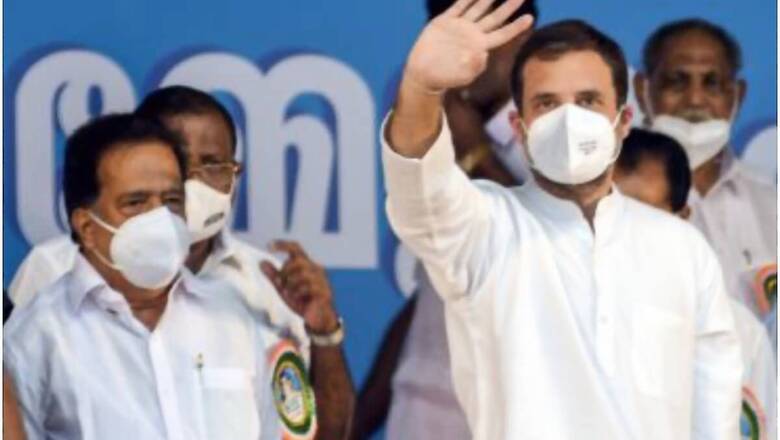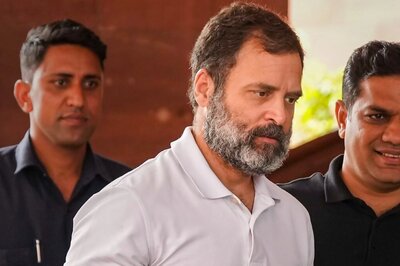
views
At 6.45pm on March 20 (Saturday), a senior journalist in Kerala received a phone call. It was from a Congress leader, someone he had met a few times and spoke to occasionally. He asked the journalist if he could head the social media team for the party. The journalist was taken aback, more than anything because the state was going to polls after 16 days. He was told to think it over and revert on March 22 (Monday), which would have left the Congress with 14 days to mount its social media offensive.
Soon, the journalist returned the call, just before 7pm, and told the leader there was no need to give the proposal any serious thought. He expressed his inability to take up the assignment, primarily as it was realistically impossible to build a social media team and construct a campaign in such a short time. Equally important, he pointed out, he was a print journalist with hardly any exposure to the social media vertical.
He then sought clarity on what anyone, journalist or not, would have found intriguing: why did the Congress drag its feet on such an important poll campaign tool till the very last minute? The answer was a typical one – the leader himself was apprised of the requirement by the party hierarchy only an hour ago. In contrast, the Left parties, especially the CPI(M), had been at the social media game for months.
Unexplained was what Anil Antony, the official social media communication head of the Congress party in Kerala and AK Antony’s son, was doing all this while and how the party came to the realisation so late in the day that his efforts needed to be propped up through backroom channels. Quite a revealing anecdote, one that shed light into its level of preparedness and the manner in which the Congress faced the 15th Kerala Assembly elections.
The Game Plan That Backfired
It was the same inertia or back-drag that was evident at the AICC High Command when it kept the Kerala leaders waiting for over a week before releasing the candidate list with a liberal dose of changes on March 14. It was as if the party leaders, including those pulling the strings from Delhi, strongly believed that the Congress was all set to lead the UDF to form the next government in the state and that the election was a mere formality. Such was the level of complacency among party leaders. Perhaps they were betting heavily on the theory of one coalition front replacing the other each election, a pattern that had held true for a good four decades, since 1980.
Therefore, when the Congress cheerleaders hailed the introduction of quite a few fresh faces in its candidate list — many of them were handpicked for their poor socio-economic background — conveniently forgotten was the fragile organisational structure of the party. Also ignored was the need to make the necessary revamp at the helm, instead presenting a team of leaders in charge of the poll campaign.
The High Command’s game plan, to keep them guessing till the last minute on its Chief Minister candidate, was not lost on state leaders. Caution being the overriding sentiment, these compartmentalised leaders remained bits-and-parts players, no single person having the gumption to position himself as the outright leader.
Result: While the LDF had Chief Minister Pinarayi Vijayan leading the charge, there was a vacuum in the UDF, with the Congress embroiled in steering committees and collective decisions. The people of a state going through the worst phase of Covid onslaught had no hesitation in holding on to the one familiar with handling the crisis, rather than choose to experiment with a dispensation which could hoist any one that Delhi chose as their next Chief Minister. They chose stability over disruption.
Symptomatic of what ails the Congress party at the central level, the Kerala leaders too were clueless about the grassroots sentiments. There was no strategy in place to counter the distrust that had developed between the two minority communities, Muslims and Christians, who constitute a bulk of the UDF vote bank. Evidently, the UDF was unaware that a significant number of its Muslim base was gravitating towards the Left Front in Malabar and something pretty much similar was happening within its Christian fold in mid-Travancore. Unless they knew it but did not think it was an issue worth addressing. In which case it would have been nothing short of criminal negligence.
Between complacency, lack of foresight and a lack of leadership, the Congress leadership, both at the central level and in the state, have been found wanting yet again. Even the local body election setbacks late last year proved inadequate to wake them up from their slumber as the High Command, for reason it will find difficult to explain now, did not heed to the wake-up calls from a number of senior Kerala leaders.
A Wake-up Call
Meanwhile, its one big strategy to field a strong, serious candidate at Nemom, the only seat won by the BJP last time, backfired in a manner it did not foresee. Sure, it was the CPI(M), not the Congress, that managed to vanquish the BJP from what was billed by the saffron brigade as Gujarat of Kerala. Yet, by making a deal out of trying to vanquish the BJP at Nemom, a sense of disaffection for the party set in within a section of Hindu voters who had till now remained within the UDF fold, and this alienation reverberated beyond the boundaries of one constituency.
Many such voters across the state have come out with narratives about why the Congress made such a big show of shutting out the BJP. Ironically, it was the CPI(M)-led led Left parties who walked away with even that banner – defenders of Kerala against the BJP onslaught.
Caught between an almost non-existent organisational structure and a section of its Muslim, Christian and Hindu voters abandoning them and, at the same time, feeding on a misplaced sense of complacency, all that the party had going was the strong belief that in the game of alternating power between the LDF and UDF, it was their turn to rule.
They put a premium on the things they had going their way and, characteristically, allowed those advantages to fizzle out or turn damp squibs. The slew of charges brought up by Opposition leader Ramesh Chennithala against the government, many targeting Pinarayi Vijayan personally, failed to gain traction as the force of the pro-incumbent sentiment flattened everything in its path. Ramesh failed to get his party to take his allegations to the people. The backseat driving efforts of KC Venugopal, supposedly on behalf of the High Command, reflected the desperation in Delhi to defend one of its last-standing power centres.
The hunt for scapegoats has already begun. State Congress president Mullappally Ramachandran, who got noticed more by his absence during the pre-poll days, and Ramesh Chennithala, who led the Opposition bench for the past five years, could find themselves at the receiving end of the witch-hunt. Oommen Chandy, beset with a host of ailments, too may find it difficult to motivate himself.
Speaking of Chandy, who was not too long ago a leader of the masses and was forced to go into hibernation by a know-it-all high command, the state unit of the Congress will not only have to cure itself of the habit of looking to Delhi for approval time and again but also have to proactively block attempts by the Delhi coterie to interfere in state matters. In other words, the time is ripe for it to cut the apron strings.
Otherwise, the prevailing political ecosystem which favours the emergence of parties rooted to a particular state may encourage a number of disenchanted Congress leaders to float their own outfits. That is unless they are desperate enough to join the BJP, despite its recent failure in the state, not only by losing its lone seat but also allowing a significant erosion of its vote share.
At the end of the day, if the Congress harbours any hope of reviving its fortunes in Kerala, it desperately needs to rebuild itself from the grassroots and hold elections all the way up to the AICC president and get its Working Committee off its non-working mode. Till such time, the party will face questions of credibility and continue to face a cash crunch that proved debilitating for many Congress newbie candidates in Kerala this time.
This is the last in the seven-part series on the Kerala elections.
Read all the Latest News, Breaking News and Coronavirus News here. Follow us on Facebook, Twitter and Telegram.




















Comments
0 comment